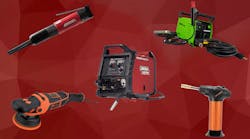Polishing is the process of creating a smooth and shiny surface by rubbing the surface, or using a chemical formula.
To facilitate this, besides the compound to be used, the tools are important factors in the consideration as well. Instead of using regular hand tools, different tools are developed to assist the technicians to accomplish the job at an efficient and cost-effective ways. This service can bring a value added service to customers and bring in more revenue to your shop.
There are two areas that will require polishing and buffing. One is the large smooth area such as the panels and hood, the others are smaller areas, corners, groves and such are often left to manual rubbing.
For larger areas, the polishing shop technician has a very important job. For instance, in order to get a good finish, it is necessary to deceive the eye. As a result, a good technician will never use a concentric polisher because they move in perfect circles. An eccentric polisher is one that moves off center. It has two functions: one is to distribute the compound evenly, by pushing it into the center to allow for even distribution, and also preventing splattering of the compound.
The other function is to confuse the eye so that the eye doesn't see any light reflected in the lines left by a conventional concentric polisher. Conventionally, 7” buffer/polishers are developed to assist in buffing jobs. To provide a constant power source, pneumatic tools are the generally used.
For smaller areas, a smaller size buffer will allow access to these areas, and the time to completion will be sped up dramatically. Traditionally, shop have used 3” pneumatic buffers for these jobs. Now, with the smaller area/touch-ups, cordless tool are designed to give better performance compare to pneumatic tools, without cumbersome cord or hose to drag around.
Besides smaller areas for buffing corners and grooves, smaller buffers aid in headlight restoration. All vehicle headlights come from the factory with ultraviolet (UV) coating designed to last for several years. Over time, natural sunlight will cause the headlights to slowly oxidize, which will cloud or discolor the light cover, causing not only a poor cosmetic appearance, but also restricting the brightness of the headlights. Headlight replacement is a very expensive option, and the alternative is to restore the headlamps with a quality UV coating and curing process. This would not be possible with a conventional polisher/buffer at 7” size due to the curve and contour of the piece.

